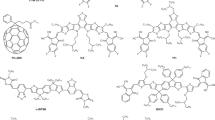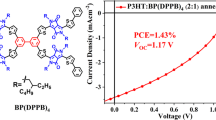Abstract
So far, one of the fundamental limitations of organic photovoltaic (OPV) device power conversion efficiencies (PCEs) has been the low voltage output caused by a molecular orbital mismatch between the donor polymer and acceptor molecules. Here, we present a means of addressing the low voltage output by introducing novel trimetallic nitride endohedral fullerenes (TNEFs) as acceptor materials for use in photovoltaic devices. TNEFs were discovered in 1999 by Stevenson et al. 1; for the first time derivatives of the TNEF acceptor, Lu3N@C80, are synthesized and integrated into OPV devices. The reduced energy offset of the molecular orbitals of Lu3N@C80 to the donor, poly(3-hexyl)thiophene (P3HT), reduces energy losses in the charge transfer process and increases the open circuit voltage (Voc) to 260 mV above reference devices made with [6,6]-phenyl-C61-butyric methyl ester (C60-PCBM) acceptor. PCEs >4% have been observed using P3HT as the donor material. This work clears a path towards higher PCEs in OPV devices by demonstrating that high-yield charge separation can occur with OPV systems that have a reduced donor/acceptor lowest unoccupied molecular orbital energy offset.
This is a preview of subscription content, access via your institution
Access options
Subscribe to this journal
Receive 12 print issues and online access
$259.00 per year
only $21.58 per issue
Buy this article
- Purchase on Springer Link
- Instant access to full article PDF
Prices may be subject to local taxes which are calculated during checkout





Similar content being viewed by others
References
Stevenson, S. et al. Small-bandgap endohedral metallofullerenes in high yield and purity. Nature 401, 55–57 (1999).
MacFarland, D. K. et al. Hydrochalarones: A novel endohedral metallofullerene platform for enhancing magnetic resonance imaging contrast. J. Med. Chem. 51, 3681–3863 (2008).
Jones, M. A. G., Taylor, R. A., Ardavan, A., Porfyrakis, K. & Briggs, G. A. D. Direct optical excitation of a fullerene-incarcerated metal ion. Chem. Phys. Lett. 428, 303–306 (2006).
Campanera, J. M., Bo, C., Olmstead, M. M., Balch, A. L. & Poblet, J. M. Bonding within the endohedral fullerenes Sc3N@C78 and Sc3N@C80 as determined by density functional calculations and reexamination of the crystal structure of {Sc3N@C78}·Co(OEP)·1.5(C6H6)·0.3(CHCl3). J. Phys. Chem. A 106, 12356–12364 (2002).
Cardona, C. M., Elliott, B. & Echegoyen, L. Unexpected chemical and electrochemical properties of M3N@C80 (M=Sc, Y, Er). J. Am. Chem. Soc. 128, 6480–6485 (2006).
Koster, L. J. A., Mihailetchi, V. D. & Blom, P. W. M. Ultimate efficiency of polymer/fullerene bulk heterojunction solar cells. Appl. Phys. Lett. 88, 0935111 (2006).
Scharber, M. C. et al. Design rules for donors in bulk-heterojunction solar cells—Towards 10% energy-conversion efficiency. Adv. Mater. 18, 789–794 (2006).
Brabec, C. J. et al. Origin of the open circuit voltage of plastic solar cells. Adv. Funct. Mater. 11, 374–380 (2001).
Kooistra, F. B. et al. Increasing the open circuit voltage of bulk-heterojunction solar cells by raising the LUMO level of the acceptor. Org. Lett. 9, 551–554 (2007).
Brabec, C. J. et al. The influence of materials work function on the open circuit voltage of plastic solar cells. Thin Solid Films 403/404, 368–372 (2002).
Lenes, M. et al. Fullerene bisadducts for enhanced open-circuit voltages and efficiencies in polymer solar cells. Adv. Mater. 20, 2116–2119 (2008).
Campanera, J. M., Bo, C. & Poblet, J. M. Exohedral reactivity of trimetallic nitride template (TNT) endohedral metallofullerenes. J. Org. Chem. 71, 46–54 (2006).
Cardona, C. M., Kitaygorodskiy, A. & Echegoyen, L. Trimetallic nitride endohedral metallofullerenes: Reactivity dictated by the encapsulated metal cluster. J. Am. Chem. Soc. 127, 10448–10453 (2005).
Rodriguez-Fortea, A., Campanera, J. M., Cardona, C. M., Echegoyen, L. & Poblet, J. M. Dancing on a fullerene surface: Isomerization of Y3N@(N-ethylpyrrolidino-C80) from the 6,6 to the 5,6 regioisomer. Angew. Chem. Int. Ed. 45, 8176–8180 (2006).
Hummelen, J. C. et al. Preparation and characterization of fulleroid and methanofullerene derivatives. J. Org. Chem. 60, 532–538 (1995).
Lukoyanova, O. et al. ‘Open rather than closed’ malonate methano-fullerene derivatives. The formation of methanofulleroid adducts of Y3N@C80 . J. Am. Chem. Soc. 129, 10423–10430 (2007).
Li, G. et al. ‘Solvent annealing’ effect in polymer solar cells based on poly(3-hexylthiophene) and methanofullerenes. Adv. Funct. Mater. 17, 1636–1644 (2007).
Erb, T. et al. Correlation between structural and optical properties of composite polymer/fullerene films for organic solar cells. Adv. Funct. Mater. 15, 1193–1196 (2005).
Peet, J. et al. Method for increasing the photoconductive response in conjugated polymer/fullerene composites. Appl. Phys. Lett. 89, 252105 (2006).
Zhokhavets, U., Erb, T., Gobsch, G., Al-Ibrahim, M. & Ambacher, O. Relation between absorption and crystallinity of poly(3-hexylthiophene)/fullerene films for plastic solar cells. Chem. Phys. Lett. 418, 347–350 (2006).
Muhlbacher, D. et al. High photovoltaic performance of a low-bandgap polymer. Adv. Mater. 18, 2931–2931 (2006).
Peet, J. et al. Efficiency enhancement in low-bandgap polymer solar cells by processing with alkane dithiols. Nature Mater. 6, 497–500 (2007).
Acknowledgements
This material is based on work supported by the Air Force Office of Scientific Research under Contract No. FA9550-06-C-0010. Any opinion, findings and conclusions or recommendations expressed in this material are those of the authors and do not necessarily reflect the views of the Air Force Office of Scientific Research. This material is also based on work supported by the National Science Foundation under Grant No. 0348955 and Grant No. IIP-0740454. Additional thanks to The Cluster of Excellence ‘Engineering of Advanced Materials’ and the Alexander von Humboldt Foundation for generous support (S.G.S.).
Author information
Authors and Affiliations
Corresponding author
Ethics declarations
Competing interests
R.B.R., E.V.K. and D.M.G. all work, or have worked, under contract for Luna Innovations, which has a financial interest in the successful application of TNEF in OPVs.
Supplementary information
Supplementary Information
Supplementary Information (PDF 1198 kb)
Rights and permissions
About this article
Cite this article
Ross, R., Cardona, C., Guldi, D. et al. Endohedral fullerenes for organic photovoltaic devices. Nature Mater 8, 208–212 (2009). https://doi.org/10.1038/nmat2379
Received:
Accepted:
Published:
Issue Date:
DOI: https://doi.org/10.1038/nmat2379
This article is cited by
-
Managing interfacial properties of planar perovskite solar cells using Y3N@C80 endohedral metallofullerene
Science China Materials (2022)
-
Molecular engineering of indenoindene-3-ethylrodanine acceptors with A2-A1-D-A1-A2 architecture for promising fullerene-free organic solar cells
Scientific Reports (2021)



